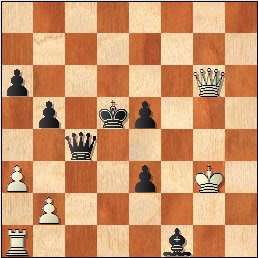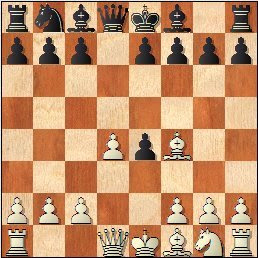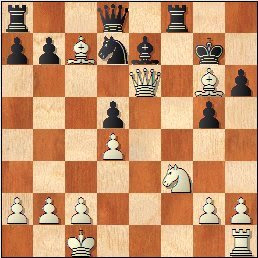In round eight Diemer faced another Yugoslavian master:
E. J. Diemer - V. Jovanovic
Beverwijk, 1956, Round 8
Alapin-Diemer Gambit Declined
1.d4 d5 2.e4 e6 3.Be3 Nf6 4.e5 Nfd7 5.f4 c5 6.c3 Nc6 7.Nf3 Be7 8.Bd3 cxd4 9.cxd4 Qb6 10.Qd2 Nb4
Black begins a time-wasting excursion on the Queenside that comes to nought.11.Be2 f5 12.Nc3 a6 13.h4 Qa5 14.Kf2 b5 15.Ng5 Qb6 16.a3 Bxg5
[Necessary, since 16...Nc6? leaves the e-pawn loose.]17.hxg5 Nc6 18.Bh5+ Ke7
[18...g6? 19.Bxg6+]19.g4 fxg4 20.f5! Ndxe5
[20...exf5?? 21.Nxd5+]21.f6+
21...Kf8
[21...gxf6? 22.gxf6+ Kf8 23.dxe5 d4 24.Bh6+ Kg8 25.f7# --Diemer)]22.dxe5 d4 23.Kg3 g6
[23...dxe3?? 24.Qd6+ Kg8 25.f7#] "What follows next is truly ingenious defense" --Diemer.24.Bxg6 Bb7 25.Bxh7 Nxe5 26.g6 dxe3 27.g7+ Kf7 28.gxh8Q Rxh8 29.Qh2!
Diemer saw the Black Queen going to c7, and then threatening mate through Ng6+ and Qf5+.29...Qc7 30.Qh6
[30.Qh5+?? Ng6+]30...Ng6+ 31.Kxg4 Qc4+ 32.Kh3 Bg2+ 33.Kg3 Rxh7 34.Qxh7+ Kxf6 35.Qh6 e5
"And now something happened which I had never experienced...for a move and a half I no longer saw the Black Queen on c4!," wrote Diemer.36.Rhf1+ Bxf1
And here Diemer was ready to play 37.Rxf1+?? when the Black Queen reappeared to him on c4. What to do? Why not another sacrifice?37.Nd5+! Ke6 38.Qxg6+ Kxd5
39.Qf7+
[39.Rd1+!]39...Kd4 40.Qxc4+ bxc4 41.Rxf1 e2 42.Re1 Ke3 43.a4 e4 44.Ra1 a5 45.Kg4 Kd2 46.Kf4
46...Kd3
[White wins after 46...e1Q 47.Rxe1 Kxe1 48.Kxe4]47.Rh1 Kc2 48.Kxe4 Kxb2 49.Re1 Kb3 50.Kd4 c3 51.Kd3 c2 52.Kd2 Kb2 53.Rc1 Kb3 54.Kxe2 Kxa4 55.Kd2 Kb3 56.Rxc2 a4 57.Kc1 1-0
With one round remaining, Diemer had only to avoid a loss to win sole first place. In still another Sicilian Defense, "ein Schachmeister, der niemals auf Remis spielte," a chess master who never played for a draw, drew in 37 moves with another Amsterdam player named Donk. Diemer finished with 6.5 points, one-half point ahead of the second-place finisher, Crabbendam.
Although he went the entire tournament without playing a single Blackmar-Diemer Gambit, for E. J. Diemer it was a good beginning to what turned out to be a very good year.
(This article originally appeared in BDG World 20, May-June 1985.)




























